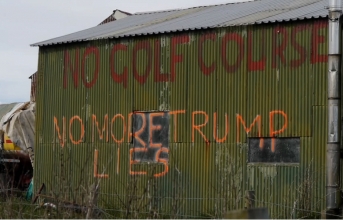Voice’s Old Susannah casts her eye over recent events, stories, and terms and phrases familiar as well as freshly ‘spun’, which will be forever etched in the consciousness of the people of Aberdeen and the Northeast.
Old Susannah is still reeling from the Friends of Union Terrace Gardens Ceilidh held last Friday night at the Hilton Treetops. The ‘vocal minority’ as the Council likes to call the Friends was certainly vocal on the night, and the excellent Ceilidh band was ‘vibrant and dynamic’ – so much so that we upset the party in the next room, which happened to be Aberdeen Football Club!
A red-faced man from AFC was ever so slightly angry and spent his entire night yelling at the hotel staff that; ‘he had spent a lot of money’, and ‘’didn’t expect to hear a band’ during his event.
Actually, I could barely hear the band over this refined gentleman for most of the night. He was obviously very important, because he kept saying who he was.
Eventually many of us took our drinks out of our room and sat on sofas watching his endless tirade. If AFC players had his stamina, then there would be more silverware in their trophy cabinet. I can only hope we have not inconvenienced Mr Milne himself.
Anyway, the Friends raised lots of money; Anne Begg made a moving speech and everyone (except the AFC man) had a fantastic night.
On Sunday I took advantage of the opportunity to watch ‘you’ve been trumped’ again.
Anthony Baxter did another Q&A session and was joined by Menie resident, Susan Munroe. The giant mound of earth and sand those nice Trump people left next to her house, (no doubt for a very important reason) is having a wonderful effect on her garden and her car. The garden is dying (so less work for her to tend it) and the car is clogged with sand (so that means less C02 emissions – another result).
The Q&A session wound up in the Belmont’s bar and continued for quite some time. Anthony is looking forward to his New York film premier, as you might well expect.
I suspect in reality he’s just hoping Trump will show up and bring his lovely young wife Melania with him – I’m sure Anthony is hoping for an introduction. Then again, I may be wrong about that. Anthony definitely sends his thanks to the Belmont and the people in Aberdeen who have turned out for the film.
But the real story of this past week was the rise of 26 year-old Callum McCaig, now installed as the new leader of Aberdeen City Council. It is pointless to make jokes about his youth; he is bringing his year of experience to the job. Rumours that he wants to turn Union Terrace Gardens into a skateboard park are (so far) unfounded.
I am actually going to give him the benefit of the doubt for the present. To be honest, when I was 26 my interests lay in other directions, but the less said about that the better. He says he wants to listen to what the people are saying. Is it possible he is embracing….
Community Engagement:
(modern English phrase) involvement of a group of people in decision-making processes.
If you read the many wonderful booklets and reports the City and its army of quangos and consultants have written over the past 10 years (well, a girl has to have a hobby), you will realise what lengths the City has gone to in its quest to ensure we are all given a voice in planning. The City might not actually listen to that voice (viz Union Terrace Gardens, the Tullos Hill Deer Cull, school closures, etc etc). – but it’s awfully nice of them to give us a voice all the same. To quote from some of their literature, here is what the city kindly does with us:-
Effective Community Engagement means:
- Ensuring that people are made aware of proposals that affect them as early as possible.
- Appropriate systems are in place to allow their opinions to be made, shared, and considered.
- To allow better explanations to be made by the Council as to how and why specific decisions on design issues have been arrived at.
- Help to implement the principles of Inclusive Design.
- Help develop greater interest and transparency in the planning system.
- Involving people across the whole public spectrum.
The ‘Inclusive Design’ implementation has long been a personal favourite. I don’t understand what this phrase means in the slightest but it certainly sounds both important and beneficial. Please feel free to send me some examples of Inclusive Design the City has put in place.
I could be forgiven for thinking that in its haste to improve our lives; the City might have forgotten these principles on a few occasions. Let’s look at these points again as applied to the Tullos Hill and other current situations (my comments are in bluish):-
- Ensuring that people are made aware of proposals that affect them as early as possible.
I don’t remember the part when the City told us a deer cull was coming for their tree programme, but I do remember they and SNH wanted to keep the cull quiet.
- Appropriate systems are in place to allow their opinions to be made, shared, and considered.
The public were allowed to comment on the tree planting until the end of January. This was the ‘phase 2 consultation’. However, once we found out that the cull was part of this phase 2 plan and that it had been kept secret, we were told we could not share our opinions. That nice Ms Aileen Malone and other Lib Dems refused to let me and the Nigg Community Council representative address the May Housing Committee with this new information: because she had only asked for a verbal report on the cull, not a written one.
Democracy in action! Or is that Democracy inaction? You could be forgiven for thinking it was a sneaky, underhanded, undemocratic ploy on (HoMalone’s) part– but if the City says it has systems in place for public opinion sharing then who are we to question it?
- To allow better explanations to be made by the Council as to how and why specific decisions on design issues have been arrived at.
The deer campaigners keep asking why the cull was kept secret, why we can’t have non-lethal measures, why the trees have to be there at all. The Council either ignore these questions, or keep repeating that a cull ‘…is standard practice for maintaining woodlands throughout Scotland.’ It doesn’t seem to matter much that there is no woodland on the hill at present, just the deer.
- Help to implement the principles of Inclusive Design.
Again, Inclusive Design is fantastic. This is being shown to great effect in the ongoing Union Terrace Gardens saga. The inclusivity seems a bit limited to a few millionaires, ACSEF and Scottish Enterprise, but hey ho.
- Help develop greater interest and transparency in the planning system.
I have to say I find the planning system very very transparent: I can see straight through it when it comes to Union Terrace Gardens, Loirston Loch, and Tullos Hill.
- Involving people across the whole public spectrum.
Fantastic! Four Community Councils at least have condemned the cull and its handling. Two thousand five hundred local people signed petitions against it. And what does the City’s Chief Executive say?
It says that this only represents a small number of people.
It seems inclusion doesn’t mean including groups of only a few thousand members. I’ll get the hang of who does and doesn’t get included yet.
Now that we have seen how Community Engagement works, I hope we can all appreciate just how important our opinions as taxpayers and residents are to our City.
Maybe this is one engagement that should be broken off.
Open Plan:
(adjective) description of a style of interior layout, particularly in an office situation, characterised by the lack of walls.
The idea was to create an open area where information would free-flow. The reality however is that people in such areas have no privacy and are under pressure to conform. Most companies are getting rid of such uncomfortable, noisy interior layouts. But not our City.
Inside the new Marischal College, aesthetic sensibility rules OK.
Staff who were lucky enough to be moved to this open plan nirvana had been told they could bring a maximum of two packing crates of their files / work with them – and one of those crates was for their computer (unless a new machine had been laid on). Thankfully architectural and interior design principles will continue to guide how things operate – staff cannot have any personal mementos or – heaven forbid – plants on their desks!
What would it look like if people could have their desk look the way they wanted? Chaos would ensue and things would not look as uniform as a factory. There is a horrible fear that someone will spill something on the new carpets.
I am sure our 65 million pound wonder building won’t have any acoustic problems; no doubt there are acoustic tiles and such in place. Since shouting, swearing and screaming are rarely heard in the City’s hallowed halls, I’m sure everyone will get on in the new office just fine.
Other staff members are being moved around from building to building; it certainly keeps things lively.
Next week: Definitions, Deer info, and I attempt to contact Neil Fletcher again with a civil question.








